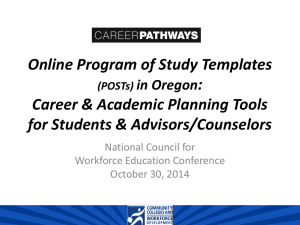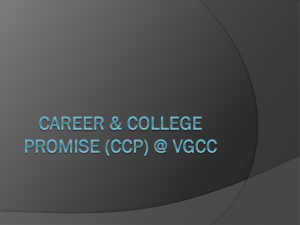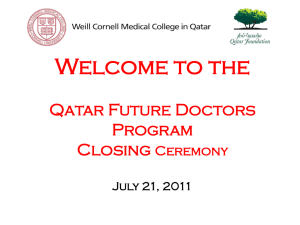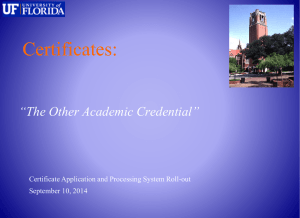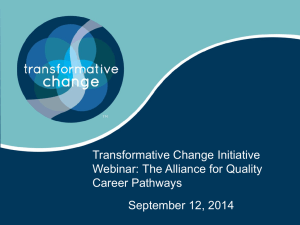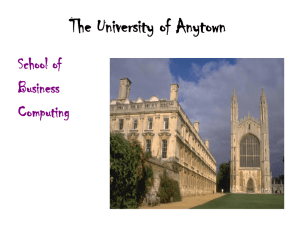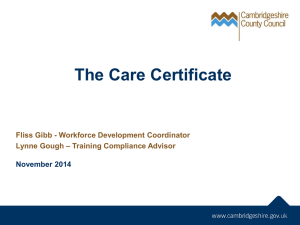Career Pathway Certificates at Klamath & Umpqua
advertisement
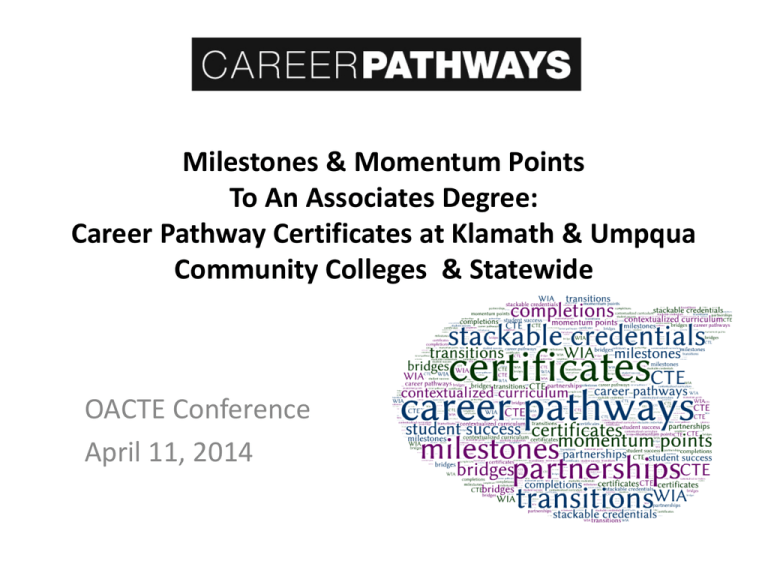
Milestones & Momentum Points To An Associates Degree: Career Pathway Certificates at Klamath & Umpqua Community Colleges & Statewide OACTE Conference April 11, 2014 Career Pathways Initiative Guiding Vision • In service of meeting Oregon’s 40-40-20 goal for the “middle 40” • Certificate completion & continued education • Address the changing needs of employers, job seekers, workers, and students • Focus on Career & Technical Education (CTE) short-term certificates tied to occupations Goals • To increase the number of Oregonians with certificates, credentials, and degrees • To ease transitions across the education continuum—high school to community college; pre-college (ABE/GED/ESL) to postsecondary credit ; community college to university; and to employment What’s a Career Pathway? Career Pathways are linked education and training services that enable students, often while they are working, to advance over time to successfully high education and employment in a given industry or occupational sector. Each step of a Career is designed to prepare students to prepare student stop progress to the next level of employment and education. What’s a Career Pathway? (continued) Career Pathways focus on easing and facilitating student transition--- from high school to community college; - from pre-college courses (ABE/GED/ESL) to credit postsecondary; - from community college to university or employment. Career Pathway Marketing & Communications • 400+ Career Pathways Roadmaps available through 17 community college websites & OLMIS Occupational Reports • www.MyPathCareers.org/cp • 30 second TV/radio spot statewide -6 months • http://www2.clackamas.edu/pathways/ • 90 second video by Lane Community College: • http://lanecc.edu/pathways • MyPathCareers brochure & Roadmaps “card” Policy Direction Drives Increased Completions • State Board of Education approved Career Pathway Certificate (CPCC) effective July 1, 2007. • CTE program Certificates tied to competencies for jobs in local labor market & approved by employers • More than 300 Career Pathway Certificates offered statewide (12-44 credits) • More than 100 Less Than One Year (LTOY) Certificates offered already offered statewide (12-44 credits) • Average number of credits for certificates: 22 • More than 7600 certificates have been awarded since 2008 • Pathways Descriptive Study of initial cohort of completers released March 2013 www.oregon.gov/CCWD Stackable Credentials • Career & Technical Education (CTE) • Occupations in six career focus areas • Short-term certificates (12-44 credits): – Career Pathway Certificates (CPCC) – Less Than One Year Certificate (LTOY) • Examples of stackable credentials for Lower Divison Transfer: Oregon Transfer Module (OTM) & Associate of Arts Oregon Transfer (AAOT) Financial Aid Guidelines Federal and state financial aid is not designed for short-term Certificate programs and does not fund most Career Pathway, Less Than One Year (LTOY), and other stand-alone 12-44 credit Certificate Programs. Career Pathway, LTOY, and other stand-alone Certificates that are 36-44 credits and three terms in length can be submitted on a college’s Program Participation Agreement (PPA) and considered for federal and state financial aid. This guideline is similar for Apprenticeship Certificates. While many students are not entirely certain of their major goal when they enter community college and apply for financial aid, declaring an associate degree as their major goal allows students the most options to attain a certificate or degree. Students who declare a course of study as an Associate Degree can obtain a Career Pathway Certificate, LTOY, or other stand-alone Certificate as they complete the required coursework toward attaining their degree goal. Career Pathway Certificates & Less Than One Year Certificates are “momentum points” in student progression toward an associate degree. Pathways Descriptive Study: Baseline Data • Initial cohort: 2008/09 and 2009/10 completers: 1461 completers • 96 percent of completers had SSNs that allowed for employment impact analysis; 92 percent of cohort had Oregon wage data • Scope: Includes both Career Pathways Certificates (CPCC) and Less Than One Year Certificates (LTOY); both are 12-44 credits • Data sources: OCCURS, CCWD Program Submission, OED wage data • Limitations: no “universe” or comparison group possible; wage data limited to Oregon; continued education data limited to Oregon community colleges; no data available on employment in same career focus area as certificate • Full report: www.oregon.gov/CCWD scroll to middle of home page Descriptive Completer Findings • Short-term certificate completions nearly evenly divided between men and women • Most certificate completers were over 25 years and many older than 45 years (28% were 45-64 yrs. of age) • Less than 5 percent of completers took an ABS course one or two years prior to completion (ABE/GED/ESL) • Approximately one-third of completers took a Developmental Education course one year prior to completion • 38.9% completer cohort also enrolled in WIA program • Two career areas with highest number of certificate awards: – Industrial & Engineering Systems – Business & Management Career Pathway Certificates at Umpqua Community College Career Pathways at Umpqua Community College • Since 2008, we’ve developed 14 Career Pathway Certificates in areas as diverse as entrepreneurship to viticulture • We have 10 career pathway certificates in development ABS and Career Pathways • From the start, we’ve tied our work on Career Pathways closely to our Adult Basic Skills program • We’ve tried various strategies to get students enrolled in ABS classes interested in Career Pathway Certificates • Early variations included developing a term-byterm planner for students to map out possible degree programs with a CPC embedded to having students co-enroll in a pre-selected Career Pathway Certificate area with varying levels of success. ABS and Career Pathways • Currently, we are developing a transition program that will be embedded in our GED classes and that will introduce our students to the roadmaps and Career Pathways Certificates. • We use the roadmaps during our ABS orientations and will also use them to follow-up in individual advising conversations with students enrolled in ABS. • Emphasis on momentum points and stackable credentials. Successes • Better integration of career pathways in campus culture, including strategic plan • New, more varied career pathway certificates • Refocusing of our catalog to better match visual representation of pathways model • Pilot project with two charter high schools to put dual credit students on career pathways certificate path • Using data to determine students close to completion of career pathways certificate Challenges • Employer buy-in in our region • Not having certificates in areas with greatest employment need or student interest • Initially, not having a strong faculty buy-in • High level of transition and turnover in administrators and at department chair level in some key areas, like healthcare Career Pathway Certificates Options for Students Many students are not able to attend college and complete a one year certificate or a two year degree Students “Self-Advise” Career Direction Prerequisites Class Schedules KCC’s Approach Illustrate Career Paths Through “Roadmaps” “Modularize” Curriculum Combine Certificate Completions with Industry-Recognized Credentials Benefits Students Businesses Colleges Community Challenges/Opportunities Course Content Business entry level needs and university transfer needs Combine NCRC with Career Pathway Certificate WorkSource leverage Business Awareness Continue Current Efforts No large scale employer, outreach to many mall businesses Eight areas of ASE certifications; create ”stackable” credentials For More Information… Mimi Maduro, Pathways Initiative Statewide Director Oregon Department of Community Colleges & Workforce Development (CCWD) 541-506-6105 mmaduro@cgcc.edu Ali Mageehon, Umpqua Community College 541-440-4720 ali.mageehon@umpqua.edu Paula Pence, Grants Manager Klamath Community College 541-880-2235 pence@klamathcc.edu
